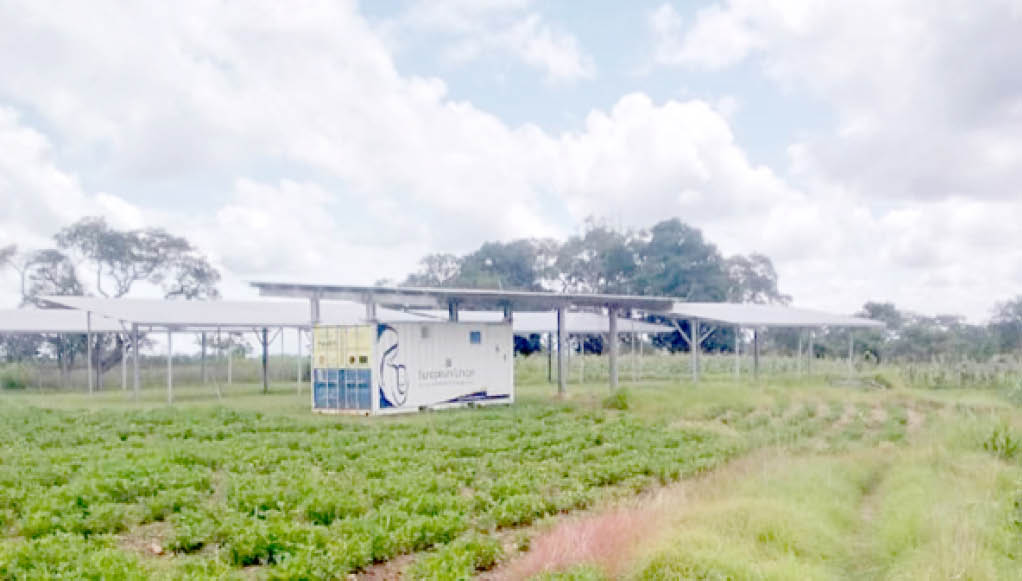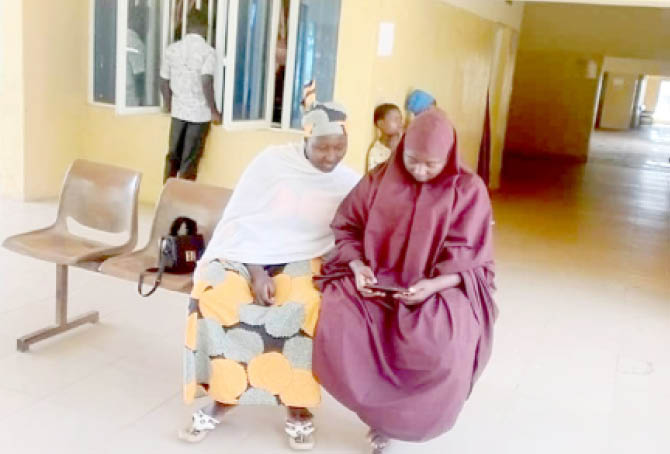How microgrids provide life-saving interventions for Kaduna villagers
Acute power shortage has crippled health facilities, particularly in many hard-to-reach communities in Nigeria and Africa at large, leaving millions of people at the mercy of poor healthcare. Daily Trust Saturday reports that a renewable energy system is changing the narrative in some rural areas in Kaduna, Northwestern Nigeria, with a potential to significantly transform […]

Solar Microgrid at Idon Rural Hospital
Acute power shortage has crippled health facilities, particularly in many hard-to-reach communities in Nigeria and Africa at large, leaving millions of people at the mercy of poor healthcare. Daily Trust Saturday reports that a renewable energy system is changing the narrative in some rural areas in Kaduna, Northwestern Nigeria, with a potential to significantly transform healthcare in the country and continent-wide.
A team of health workers enabled by anaesthetic machine and surgical lights working seamlessly under a 47.5 Kilowatts solar power system saw Mrs Laraba Ado through a prolonged labour late April at Idon Rural Hospital.
Sharp repeated cries of a newborn had cut through the quiet ambience of the hospital ward at the dead of night, signifying a successful caesarean section that lasted about 40 minutes.
“Mother and child were fine and everyone wore beautiful smiles,” a team member and nurse, Mrs Gladys Yatai, recalled.
- It’s wrong to be minister while serving, NYSC tells Musawa
- Niger crisis: Terrorists shoot driver, burn trucks conveying foodstuff to Ghana
Some three years ago, childbirth at the healthcare centre in Kajuru Local Government Area of Kaduna State was highly risky, no thanks to outages that brought service delivery to its knees.
“Back then, we were afraid of admitting pregnant women in labour and patients in emergency conditions because there was poor power supply. The solar power has helped in service delivery tremendously. We now handle two to three childbirths every week and sometimes it could be more,” Yatai said.
Mrs Angelina Joseph, a women leader in Idon, said in the past when erratic energy supply from the national grid crippled the hospital, many pregnant women preferred travelling to the city centre to give birth at health facilities with relatively stable power.
“We could have lost her (Laraba Ado) and the baby without the solar power that night. Something terrible might happen on the road before she gets to a hospital in Kachia, about 33km from here [Idon] or Kaduna, the state capital, which is over a 100km distance,” Joseph told Daily Trust Saturday.
The ugly scenarios began to change in 2020 when the solar microgrid jolted the rural health centre to life from near paralysis.
According to Berkeley Lab, a microgrid consists of energy generation and energy storage system that can power a building, campus, hospital or community. A microgrid can be an isolated system operating only off-grid or grid-connected operating synchronously with macrogrid (national grid), but can also function independently in “Island mode.” The latter is what obtains in Idon Rural Hospital.

Though darkness still envelopes hundreds of houses connected to the national grid, locals are excited over round-the-clock power supply at the health centre servicing Idon and 20 surrounding villages and hamlets of over 50,000 people, said Bitruce Ahmadu, the community’s immediate past district head.
“It is a life-saving turnaround. Unlike in the past when outages informed most referrals by the hospital, they now refer patients on a few occasions where they don’t have enough capacity to handle certain complex medical conditions,” he added.
Power burden in health sector
About 600 million people in Sub-Saharan Africa, representing 43 per cent of the region’s population, lack access to energy in 2022, according to the World Bank. Most of the affected population reside in rural communities such as Idon and its environs.
In Nigeria where power generation hovers around 5,000 megawatts (about 15 per cent of the 33,000MW the Association of the Nigerian Electricity Distributors says is needed for stable electricity), the national grid is not accessible to at least 85 million people of the over 200 million population, making it the country with the largest energy access deficit in the world.
Nearly half of Nigeria’s population, the most populous in Africa, live in rural areas without access to electricity. Invariably, this negatively impacts health facilities in those areas.
Reliable power is central to delivering quality and timely healthcare. Sadly, a large number of health centres, mostly in rural communities across Nigeria, either survive on epileptic energy from the grid or fossil-fuel powered generators.
Of the 60 primary health care centres (PHCs) surveyed in a 2018 study on the energy situation in Nigerian PHCs by Heinrich Böll Stiftung, a German political foundation in Africa, 57 per cent of the PHCs were connected to the national grid providing power for just an average of four hours or less daily, while 43 percent were off-grid.
The study was anchored on a 2017 survey by BudgIT which sampled health workers’ views on what they perceived as barriers to improved performance in healthcare centres. The 2017 survey revealed that lack of appropriate hospital equipment and access to reliable power supply were the leading barriers to improved health care delivery in Nigeria, constituting 26 per cent and 21 per cent respectively. Notably, electricity was identified as central to 79 per cent of other barriers such as access to clean water, drugs storage, functional laboratory, conducive work environment, among others.
In most cases, rural communities of hundreds or thousands of residents depend on a power-crippled hospital. The consequences oftentimes are avoidable deaths from malaria, cholera or maternal health crisis that places Nigeria second on the World Health Organisation’s list of nations with high rate of maternal and child deaths. According to a WHO report, 540 women and children ‘per thousand’ died in Nigeria in 2020.
“The role of electricity in healthcare services is very germane,” Idon Rural Hospital Medical Director, Dr Lazarus Oduma, affirmed. “In this hospital, the solar system is basically our source of electricity and the service it renders cannot be quantified.”
Solar system boosts routine immunisation, security
According to Oduma, improved routine immunisation (RI) is another remarkable impact of the solar energy on the hospital as it guarantees good storage of vaccines. Slow RI uptake remains a big issue in Nigeria and poor vaccine storage system occasioned by power epilepsy remains a major impediment.
RI is said to avert approximately 2 to 3 million deaths yearly, yet vaccination rates in Nigeria are extremely low. The 2021 Multiple Indicator Cluster Survey and National Immunisation Coverage Survey by the United Nations Children’s Fund (UNICEF) revealed that only 36 per cent of children aged 12-23 months received all recommended vaccines in Nigeria from 2016 to 2021.
“Before now, the potency of vaccines could not be guaranteed because of poor electricity. Since there is steady power supply, we no longer have issues with routine immunisation for children. We now carry out immunisation on a daily basis and we have a large turnout every Wednesday, which is a market day when traders from different villages bring their children,” Oduma said.
The medical director said Idon has been under banditry attacks in recent times, but solar energy that lights up the hospital vicinity at night has significantly helped in mitigating security threats.
“It makes us feel relatively safe. It’s our saving grace and we don’t joke with it. We do regular inspection and whenever there is any technical issue, we invite technicians to fix it,” he added.
Game changers
The power system in Idon hospital is among 13 containerised solar microgrids installed in rural health centres in Kaduna from 2019 to 2020 by EM-ONE, a Canadian-Nigerian engineering and technology firm.
The projects were executed under the Kaduna Solar for Health through the Nigerian Solar Programme – a bilateral scheme funded by the European Union and implemented by the defunct Department for International Department (now known as Foreign, Commonwealth & Development Office).
At the inauguration of the solar system in Doka Rural Hospital Kaduna in November 2019, the then Minister of Power, Engr Saleh Mamman, said the project was consistent with Nigeria’s commitment to achieve United Nation’s Sustainable Development Goal 7.
“The project demonstrates how partnership and collaboration among stakeholders can lead to concrete results. In this case, the DFID partnered with Kaduna State Government to develop this project, providing reliable electricity supply, which will improve the lives of people through improved healthcare,” Saleh had said.
The 13 solar systems are expected to offset over 520,000 litres of diesel and reduce nearly 1,400 tons of carbon emissions per year.
What is more? Reliance on microgrids in rural health facilities is about to take a leap. ENGIE Energy Access Nigeria in August 2022 unveiled its plan to connect 2,700 off-grid health centres to stable electricity over a four-year period to improve the livelihoods of rural people through renewable energy solutions.
A Professor of Electrical Engineering at the Ahmadu Bello University, Zaria, Jimoh Boyi, agreed that deployment of microgrids for quality healthcare “is the way to go.”
“There is no reason to wait for electricity grid. In most health centres in rural Africa, we can look at microgrid solutions. There are also appliances in the market that are already solar energy dependant. They can be considered for use in hospitals,” he added.
Prof Boyi urged the Nigerian government to promote local production of solar system by empowering the National Agency for Science and Engineering Infrastructure (NASENI).
“NASENI is supposed to marry whatever we do in the classroom to the industry. The moment we produce on our own, it will bring the cost down because we won’t be buying in dollars.
“Another option is while we are importing [microgrids], we can do reverse engineering. We have silicon; what we need is the technology to build solar panels. I believe that NASENI with adequate support can produce solar panels of our own,” Boyi noted.
Professor Samuel Wara, whose research interest centres on renewable energy, energy conservation and efficiency, said the government needed to come up with a comprehensive policy framework to properly integrate microgids into the health sector.
“For instance, the government can say the minimum power all health centres must provide is by solar so that theatre, intensive care unit, accident and emergency unit and general lighting can be on. Government can also give a tax holiday to those who want to invest in microgrids in the health sector. The policy can also state specifications of solar energy they should provide for effectiveness and there must be a monitoring agency,” he said.
